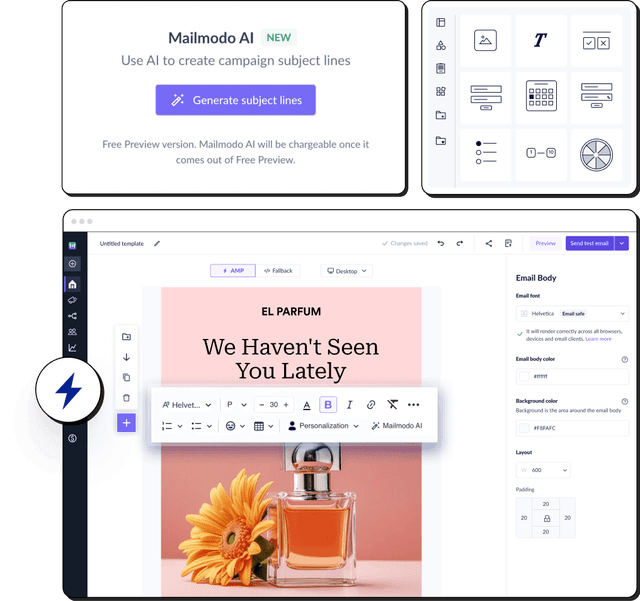What is brand voice?
A brand voice is the tone and way of communicating with your potential customers. Everything chosen to direct a message to prospects and reach specific goals. This tone differentiates the company across various channels, including the website, email newsletters, social media, TV adverts, etc.
When choosing the brand voice, you build the business image and reputation. It's like impersonating the company. How will it interact with clients? Will it be lively or reserved? Authoritative or playful? Educational or entertaining?
Why is a brand voice so important to companies?
It establishes a relationship between a company and its customers from the very beginning. It also helps you to react properly in critical situations because you'll tweak the tone of voice to express the brand's attitude to some issues. And it's a vital factor to retain clients and build loyalty. However, note that it can't substitute a user experience. Instead, it intensifies a perfect brand strategy, such as providing intuitive and personalized navigation on the website or virtual assistance 24/7.
5 easy steps to build your brand voice
Read the following tips to introduce your company with the perfect brand voice.
1. Create the buyer persona
A buyer persona is how you imagine a hypothetical individual of your target market. How do you make up such characters? You should conduct extensive studies on your target audience.
While it's impossible to know every buyer, you can get a general idea of prospects. You may have more than one buyer persona as people shop for various reasons and represent different social and demographic groups.
Where do you get these insights? Investigate your customer database, social media, and tools like Facebook Audience Insights or Google Analytics. That's how the Google Analytics interface looks.

Source: The official Google Analytics YouTube channel
After that, you can answer what role you want to play in your customers' lives. Imagine your brand as a person. Determine the possible connection between that individual and buyers.
The roles range from a teacher, a motivational speaker, a friend to an authoritative figure, the life and soul of the party, etc. Why do you need to establish the brand role? It will help you understand how to communicate with your customers and be consistent across all touchpoints.
2. Dive deep into content analysis
If you've been on the market for some time, you've probably developed a particular communication strategy. But how do you make a brand voice on social media, newsletters, and websites more consistent?
Analyze existing content, how messages vary in brand voice, and what performs best. You need to know what resonates with the target audience and leverage that information to develop a brand voice across all channels.
Below is one of the tabs on Google Analytics. This is where you can get the idea of the traffic source, the number of visitors for each channel, visit duration, bounce rate, and more. If you notice that your newsletter communication style brings more traffic, you can use it as an example to strive for.

Source: The official Google Analytics YouTube channel
3. Align the brand voice with the price tag
Have you noticed how differently you feel in stores or restaurants, depending on the average price in this place? It happens because brands tailor their strategies based on how much their target audience is willing to spend.
Premium brands are generally more formal in their interactions. However, luxury doesn't mean boring. Modern buyers demand openness and a casual approach from businesses. It happened due to social media growth, allowing them to communicate with brands directly. That's why many luxury stores move away from the image of distant and impersonal companies and use the light brand voice.
One of them is Hermès. The company's brand voice is luxuriously playful. It doesn't try to build a wall between clients and the brand but strives to present a classy image that is light and lively. Do you see what calls to action Hermès utilizes? "Ready, set, go" instead of overused "Buy now." They set the appropriate mood and don't make you feel obliged or uncomfortable.

Source: Screenshot taken on the official Hermès website
4. Use an appropriate tone for your brand voice
Brand voice is what you say. How you say is what the brand tone denotes. They work together to deliver the message depending on the audience. Your task is to keep track of the scenarios when to employ different tones.
A tone of voice may change depending on the cases, such as formal media statements and casual social media posts. For example, the tone of voice won't be the same when you're announcing a new product and when you're reacting to a customer complaint, agree? Determine the typical circumstances you encounter like a brand. Match them with various tones.
A case in point is Sephora. The cosmetics company targets primarily millennial women. The brand strategy's tone is reserved, as you can notice from their laconic and informative logo, numerous tips, guides, and other educational materials. Sephora's content is practical and valuable.
The company seems to keep the boundaries of decency and doesn't use slang or other references to the informal communication style. You can verify this if you go to the site's main page. The above-the-fold banner contains only essential information. Nothing extra.

Source: Screenshot taken on the official Sephora website
Sephora promotes the educational emphasis across social media, such as Instagram, by reposting user-generated reviews, pieces of advice, and images. But do you see how it changes its tone of communication on social networks? This is where informal words ("amp up"), emojis, an exclamation mark, and capitalized phrases come in. The brand aims to be closer to the audience and liven up the message.

Source: Screenshot taken on the official Sephora Instagram account
5. Adhere to your visual branding
Visual identity, often known as visual branding, is how you represent a company's beliefs and personality by appealing to your customers' eyes. It creates an emotional connection with the help of colors, forms, and typefaces in the company's logo, website, business cards, etc.
Consistent visuals are tools to match your visual branding approach with different components, such as a voice. They indicate that it is your company speaking. It's how your target customer will perceive the brand while seeing an email newsletter, an Instagram post, or a brochure.
For example, you may not even read the text, but the predominant colors will tell you whether it's an electronic or kid's store. Make visual branding your ally in determining the brand voice. If you've been using your visual identity successfully, why not choose suitable wording in line with it?
Below is the Missguided online store. The leading brand motive is inspiration and girl empowerment, sometimes turning into audacity and playfulness. You can notice their focus on bold women through visuals and informal language resonating with its female 16-25-year-old audience.

Source: Screenshot taken on the official Missguided website
Final thoughts
Selling goods is not just about satisfying basic needs. The competition is high, so you need to improve customer experience proactively before they leave your website. Create a particular atmosphere around the brand as clients now value a feeling of community and uniqueness at the same time. Brand voice helps you deliver the needed message and convert visitors into buyers. Check out our guide to determine how you can make your user's buying journey easier, shorter, and smoother by improving their experience!
What you should do next
Hey there, thanks for reading till the end. Here are 3 ways we can help you grow your business:
Talk to an email expert. Need someone to take your email marketing to the next level? Mailmodo’s experts are here for you. Schedule a 30-minute email consultation. Don’t worry, it’s on the house. Book a meet here.
Send emails that bring higher conversions. Mailmodo is an ESP that helps you to create and send app-like interactive emails with forms, carts, calendars, games, and other widgets for higher conversions. Get started for free.
Get smarter with our email resources. Explore all our knowledge base here and learn about email marketing, marketing strategies, best practices, growth hacks, case studies, templates, and more. Access guides here.















